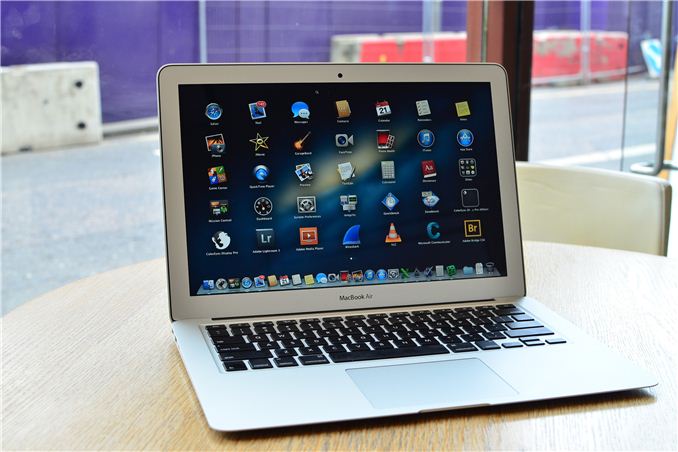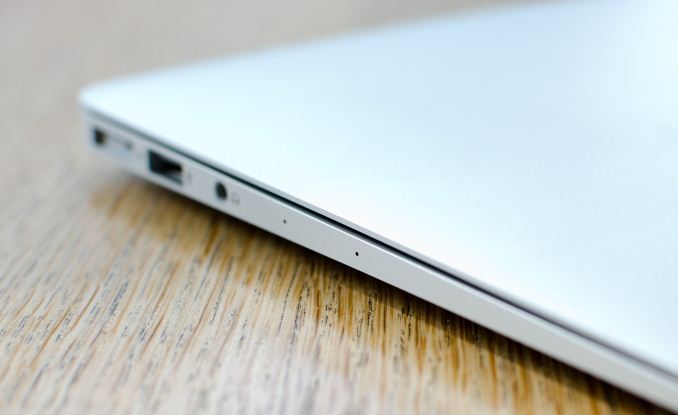The 2013 MacBook Air Review (13-inch)
by Anand Lal Shimpi on June 24, 2013 12:01 AM EST
Things didn’t go exactly as I’d expected at WWDC. I spent the week before the show at Computex, talking to PC OEMs, who had all just launched their Haswell ULT based Ultrabooks. With a couple of exceptions however, the bulk of Haswell ULT systems weren’t scheduled to ship until later this year. Even the Acer S7 I snagged while in Taipei was still a pre-production unit, with final hardware due out in the next month. Based on what I saw in Taiwan, and Intel having seeded me an Iris Pro machine the week before, I assumed that the MacBook Pro with Retina Display is what would get the Haswell treatment first. Obviously, that didn’t happen.
In hindsight, the move makes sense. Apple will sell far more MacBook Airs than rMBPs. The Apple/Intel relationship is looking very healthy these days, so it’s also not surprising that it would have supply and early enough access to Haswell ULT to launch the MBAs at WWDC with almost immediate availability. The Haswell ULT shift didn’t require a new chassis for Apple, which meant a less complex development process.
From the outside, the new MacBook Air looks nearly identical to its predecessor. There's a second mic opening on the left side of the machine now, but otherwise you'd be hard pressed to tell this year's model apart from the previous generation. Internally, nearly everything has changed.
The battery is higher capacity, with no increase in weight. Making better use of that larger battery is Intel's new Haswell ULT silicon. Since we're talking about a ULT part, the PCH moves from the motherboard to the CPU package - creating an emptier motherboard than we've seen in previous years:
The 2013 13-inch MacBook Air Motherboard, Courtesy iFixit
It's clear to me that the MBA is due for a more significant redesign, but this is not the year for that.
Alongside Haswell comes a brand new PCIe SSD, 802.11ac support and LPDDR3 memory. All at a price equal to, if not less than last year's models:
| 2013 MacBook Air Lineup | ||||||
| 11.6-inch | 11.6-inch (high-end) | 13.3-inch | 13.3-inch (high-end) | |||
| Dimensions |
H: 0.11-0.68" (0.3-1.7cm)
W: 11.8" (30cm) D: 7.56" (19.2cm) |
H: 0.11-0.68" (0.3-1.7cm)
W: 12.8" (32.5cm) D: 8.94" (22.7cm) |
||||
| Weight | 2.38 lbs (1.08kg) | 2.96 lbs (1.35kg) | ||||
| CPU | 1.3GHz dual-core Core i5 | 1.3GHz dual-core Core i5 | ||||
| GPU | Intel HD 5000 | |||||
| RAM | 4GB LPDDR3-1600 | |||||
| SSD | 128GB PCIe SSD | 256GB PCIe SSD | 128GB PCIe SSD | 256GB PCIe SSD | ||
| Display Resolution | 1366 x 768 | 1440 x 900 | ||||
| Ports | Thunderbolt, 2x USB 3.0, headphone jack | Thunderbolt, 2x USB 3.0, SD card slot, headphone jack | ||||
| Networking | 2x2:2 802.11ac | 2x2:2 802.11ac | ||||
| Battery | 38 Wh | 54 Wh | ||||
| Price | $999 | $1199 | $1099 | $1299 | ||
We've been over the MacBook Air chassis thoroughly in the past so I won't go through it again here. Build quality remains excellent. The clickpad and backlit keyboard never give me any troubles either. It's sad that we're still having clickpad issues elsewhere in ultraportables but this is one area where Apple's vertically integrated advantage is apparent (as is the company's willingness to spend a little extra on even the little details).
The only thing that hasn't changed, that perhaps should have is the display. The MacBook Air retains the same 1366 x 768/1440 x 900 panels from last year, while much of the competition has moved to at least 1080p IPS in the 13.3-inch form factor. This year at Computex we saw a number of systems move to 2560 x 1440 13.3-inch panels, at least as an option, however I'm expecting those systems to be priced more in line with the 13-inch rMBP rather than the MacBook Air. Admittedly, I don't know the right solution here.Ultra high resolution panels drive cost and power consumption up, the latter which can be offset by going to a larger battery - but then you have a 13-inch rMBP. Perhaps the right move for the MacBook Air would be for Apple to move to IPS panels at least? Or maybe we see a merger of the 13-inch MBA/rMBP, and something new entirely replace the 11-inch model.












233 Comments
View All Comments
ananduser - Monday, June 24, 2013 - link
I believe this is the first time a company has actually released a slower product than the previous gen. On principle at least Apple should be penalized in the review.Anand may I suggest a battery testing feature ? Count the time it takes to finish one iteration of the looping test. Maybe the battery lasts longer on a certain device but it may also take longer to finish the task. After that "normalize" the results to really measure the improvement.
Paapaa125 - Monday, June 24, 2013 - link
MBA 2013-mid is not really that much slower. It has a lot faster SSD, it has a lot faster WLAN. CPU equal or slower than previous and GPU is faster than previous models. For most usages the net result is a equally fast if not faster computer. Mostly because SSD.captainBOB - Tuesday, June 25, 2013 - link
Instead of going the typical route and using all the extra power savings to increase performance while maintaining the same battery life of last year's model, Apple decided to increase battery life while maintaining performance with last year's model. Its an ultraportable.If you want more juice, get a Macbook Pro, the Macbook Air is all about the ultraportability.
As for the lack of 1080p, on all those other ultrabooks with a 1080p screen, the DPI scaling is upped to 150% by default because people were complaining that text on the screen was too small, Windows still can't handle DPI scaling very well, and I doubt Windows 8.1 will change things because it will most likely be an API and still be up to the developer to update their programs to support higher resolutions. Given the "stellar" track record of the Windows desktop development community and Microsoft itself in actually USING the awesome new APIs that Microsoft creates. The situation isn't going to change the moment 8.1 comes out, it may not change for several years.
Retina may be in the Air's future, but for now the Retina display is what clearly separates the Pro from the Air.
If there is one criticism that is valid, its that the display should've been at least IPS.
ananduser - Tuesday, June 25, 2013 - link
Spare me the marketing talk please...I never mentioned anything about the screen. Why do you feel the need to explain me Apple's motives for that ?They could have very well provided a 9 hour machine with a tangible increase in performance, but hey, Apple fans don't care, everything is perfect in camp Cupertino.
PS: Since you brought it up, the Windows desktop development community is pretty stellar indeed; it's why the best software on the planet, from virtually all categories you wish to name, is made to run on Windows first and foremost. Windows(the software) always handled scaling very well, and having options like 125% or 150% is pretty nifty. Since the display pissing contest just started it will take some time until devs start to obey proper guidelines.
Paapaa125 - Tuesday, June 25, 2013 - link
It's always a tradeoff. Apple went now for maximal battery life with acceptable performance. Most likely they'll focus on performance with rMBP. Sounds logical to me. I think there are many users to whom MBA has enough CPU power and they really need all day battery life. MBA now barely delivers that. Lower battery life would've meant that it will not last all day.ananduser - Wednesday, June 26, 2013 - link
So...we Anandtech readers... we who are the most pretentious of most users... can't we provide criticism ?jmmx - Monday, June 24, 2013 - link
What would like to know is this...I assume that turbo boost speeds will more likely occur when the unit is plugged in - i.e. it will not be draining the battery. Do any of these tests take this into account? (or did I jut not read far enough yet?)
Laststop311 - Monday, June 24, 2013 - link
I totally despise apple and yes it looks like they are making a lot of mistakes with the 2013 refresh. Staying with low res screens and lower clocked processors that are actually a nudge slower than in 2012. But with the the lower clock speeds and massive battery life improvements of the haswells the macbook air is poised to be the longest running ultrabook on battery this year, especially with the larger battery that adds no weight.When you combine the fact that this is haswell, they stayed with low res screens added a larger battery and lowered the cpu frequencies we are in for a real treat with an ultrabook with an insane battery runtime that still has enough power to do everything an ultrabook is used for 99% of the time and do it it with performance in the mid the to midhigh pack with Top battery scores. Not to mention the thermals are probably so much cooler on this air. If Apple left it at 50% would would or probably seen 15 hour idle numbers from apple. And once OSx integrates the power management optimizer feature from haswell those battery life numbers will only go up. Eve more.
I hate apple. But if battery life i you're #1 concern and want to routinely pull 10 hour workdays from your machine without charging the macbook air 13 model 2013 is the ultrabook for you.
KPOM - Thursday, June 27, 2013 - link
All notebooks are about design compromises. Apparently Apple decided to tweak this one for battery life rather than use Haswell as an opportunity to put in a faster processor or better screen. Hopefully they'll find a way to shave a few ounces off the weight of the 13" rMBP. I have one and like it, but miss the portability of the Air.Laststop311 - Monday, June 24, 2013 - link
I wish sata would just completely die off and intel increased in PCI lines by double 80X on enterprise 32x on consumer and have all new HDD and SSD connect via PCI 3.0 1GB/SEC bi directional. Can just use 1x lanes for all the storage devices maybe a few 2x lane connections for super high performance ssd;s. But probably won't see this wish till 2GB/sec bi directional pcie-e 4.0. Where we can easily stack up 8 SSD's on 1s lanes while still providing enough lanes for full GPU use. I hope pci 4.0 brings the full death of sata and its outdated ways. Even if we have to call it sata express. The Use of SATA needs to be fully dead by pci-e 4.0. Yea that includes even having to run a practically obsolete blu ray burners off a 1x line but who knows by then there may be a disc much puerior yo blu ray that can actually use the extra bandwidth. Would simplify computers no longer having to have all that data hardware on there too.